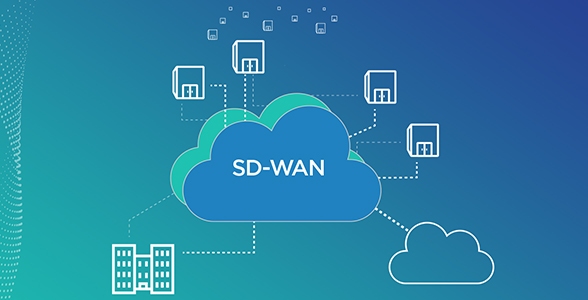What is SD-WAN?
Software-defined Wide Area Networks (SD-WAN), a software approach to managing wide-area networks, offer ease of deployment, central manageability, and reduced costs, and can improve connectivity to branch offices and the cloud.
What is SD-WAN?
Software-defined WAN (SD-WAN) technology applies software-defined networking (SDN) concepts to distribute network traffic throughout a wide area network (WAN). SD-WANs work automatically, using predefined policies to identify the most effective route for application traffic passing from branch offices to headquarters, the cloud, and the Internet. There is rarely any need to configure your routers manually in branch locations. A centralized controller manages the SD-WAN, sending policy information to all connected devices. Information technology (IT) teams can program network edge devices remotely, using low-touch or zero-touch provisioning.

How does it work?
Traditional WANs rely on physical routers to connect remote or branch users to applications hosted in data centers. Each router has a data plane, which holds the information, and a control plane, which tells the data where to go. Where data flows is typically determined by a network engineer or administrator who writes rules and policies, often manually, for each router on the network – a process that can be time-consuming and prone to errors.
SD-WAN separates the control and management processes from the underlying networking hardware, making them available as software that can be easily configured and deployed. A centralized control pane means network administrators can write new rules and policies, and then configure and deploy them across an entire network at once.
How does it help network security?
One of the bigger areas SD-WAN impacts is network security.
The tipping point for a lot of customers was the advent of applications like the cloud-based Office 365 and Amazon Web Services (AWS) applications that require secure remote access. said Neil Anderson practice director, network solutions at World Wide Technology, a technology service provider. “SD-WAN lets customers set up secure regional zones or whatever the customer needs and lets them securely direct that traffic to where it needs to go based on internal security policies. SD-WAN is about architecting and incorporating security for apps like AWS and Office 365 into your connectivity fabric. It’s a big motivator to move toward SD-WAN.”
“With SD-WAN, mission-critical traffic and assets can be partitioned and protected against vulnerabilities in other parts of the enterprise. This use case appears to be especially popular in verticals such as retail, healthcare, and financial,” IDC wrote. “SD-WAN can also protect application traffic from threats within the enterprise and from outside by leveraging a full stack of security solutions included in SD-WAN such as next-gen firewalls, IPS, URL filtering, malware protection, and cloud security.”
SD-WAN Benefits
Businesses are rapidly adopting SD-WAN technology because of its comprehensive financial and operational benefits.
- Lowers WAN OpEx, CapEx, and overall total cost of ownership.
- Provides greater business agility and responsiveness to keep pace with IT innovations.
- Supports multiple, secure, high-performance connections, eliminating backhaul penalties imposed by MPLS networks.
- Improves performance by enabling load sharing across connections and adjusting traffic flows based on network conditions.
- Supports the automated provisioning of, and changes to, premium network services such as VPNs, firewalls, security, WAN optimization, and application delivery control.
- Supports zero-touch provisioning (ZTP).
- Improves network security by encrypting WAN traffic and segmenting the network to minimize damage if breaches occur.

Why SD-WAN?
By optimizing traffic over multiple available connections, SD-WAN delivers a better user experience, anywhere. SD-WAN dynamically steers traffic to the best available link and remediates if transmission issues arise to ensure the high performance of applications.
- Performance and Reliability: Deliver hybrid WAN with high-performance reliability, transport, and provide flexibility to assure optimal performance even for demanding applications, such as voice and video.
- Cloud Network: Eliminate data center backhaul penalties with a cloud-ready network to provide an optimized direct path to public and private enterprise clouds.
- Virtual Service Platform: Reduce the branch office footprint with a single click. VMware SD-WAN enables seamless insertion and chaining of virtualized services on-premises and in the cloud.
- Automation and Orchestration: Centralized monitoring, visibility, and cloud control enable zero-touch branch deployment while delivering automatic business policy and firmware updates, link performance, and capacity measurements.